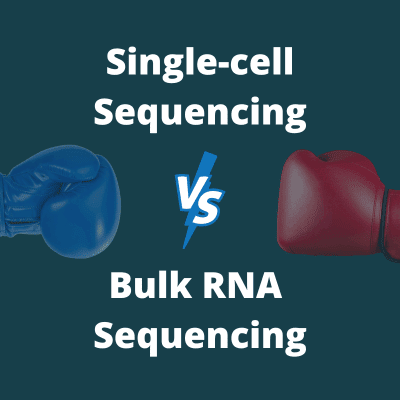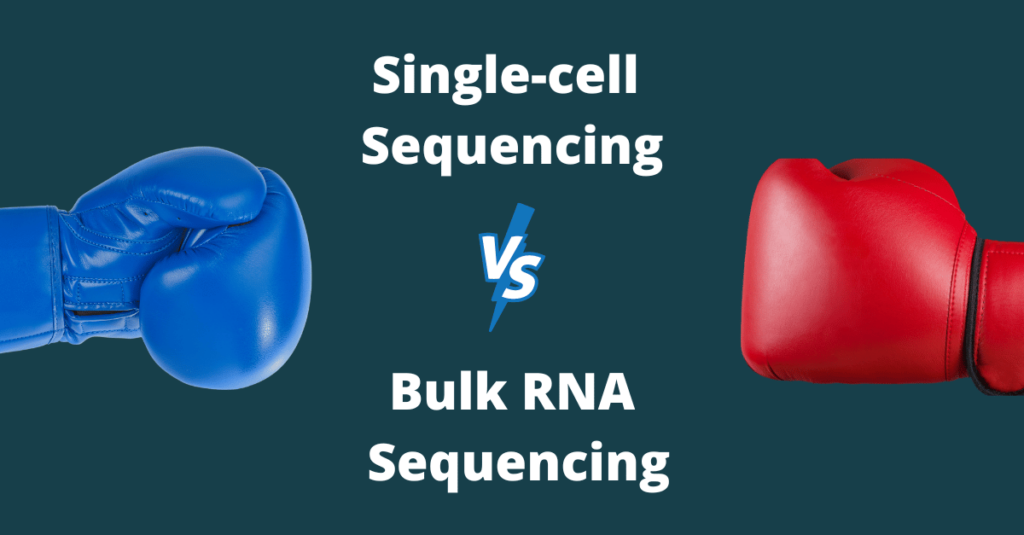Single-Cell vs Bulk RNA Sequencing
- 28th April 2023
- Posted by: Breige McBride
- Categories: Sequencing, Single Cell Analysis

Considering single-cell vs bulk RNA sequencing and not sure which to choose? Read on to discover what each sequencing method is, how they differ and which to choose when.

What is Bulk RNA Sequencing?
Bulk RNA sequencing, or RNA-seq, is a term for any sequencing method that uses the averaged gene expression from all cells in a population to identify the presence and quantity of RNA in a sample of cells. Bulk RNA Sequencing is used for transcriptome profiling (analysing the transcriptome of a cell and its changes.)
How Does Bulk RNA Sequencing Work?
Bulk RNA sequencing works by measuring the average expression level of individual genes within cells. However, the points of data generated for observation represent bulk samples of many cells rather than single-cells.
What is scRNA-seq?
Single-cell analysis studies different aspects of cells (such as their genomes, proteomes, transcriptomes and metabolomes) at an individual cell level. scRNA-seq measures the gene expression levels in individual cells. As more and more scientists were discovering the benefits of single-cell sequencing, publishing studies with exciting insights, Nature named single-cell sequencing Method of the Year 2013. This was, of course, a decisive blow in the single-cell vs bulk rna sequencing battle.
How Does Single-cell RNA-seq Work?
The first step in scRNA-seq is to isolate a single cell for analysis. Single cells can be isolated in various ways such as via serial dilution or laser capture microdissection. Other isolation techniques are manual picking or via hydrodynamic-based microfluidic biochips. Once cells are isolated, they are sorted and RNAs are tagged with a cell-specific barcode before being reverse transcribed so cDNA can be amplified to prepare the sequencing library. Single-cell RNA-seq enables the investigation of up to 20,000 individual cell’s RNA biology, simultaneously1.
Comparing Single-cell vs Bulk RNA Sequencing
The older of the two methods, bulk RNA sequencing is less expensive, less labour-intensive and less time-consuming than single-cell sequencing. In addition to transcriptome profiling, RNA-seq can assist with the discovery of novel transcripts, identifying alternatively spliced genes or detecting allele-specific expression. However, as it only measures the average expression level of a population of cells, information on heterogeneity of the cell population is unavailable.
On the other hand, scRNA-seq, although more expensive and laborious, allows for the extraction of information on heterogeneity of cell populations. Additionally, with scRNA-seq it is possible to find gene expression signatures for those cell populations and to identify biomarkers. We can also use it to see how cell types interact with each other, how their state changes in different conditions or how they transition from one state to another.2
Expert RNAseq and scRNA-seq Data Analysis
At Fios Genomics, we have a wealth of experience in both bulk RNA Sequencing data analysis and scRNA-seq data analysis. In fact, single-cell data analysis is one of our most popular analysis services. This is perhaps due our ability to quickly and economically analyse single-cell gene expression data from a range of platforms including 10X Genomics, DropSeq and SMART-Seq2. We can also receive data in various formats for analysis such as raw FastQ files, aligned BAM/SAM files, and raw count matrices.
When it comes to single-cell vs bulk RNA sequencing, no matter which method you choose, we can provide the analyses. Due to the biological and computational expertise of our bioinformaticians, we can reveal the relevant insights within your transcriptomics and single-cell data that will help you to reach your research goals. Contact us now to discuss your sequencing project or complete the form on the right to receive a sample of our scRNA-seq analysis reports.
Request a sample of our Single-Cell RNAseq data analysis reports
This report describes the analysis of a single-cell RNA sequencing (scRNA-seq) dataset containing peripheral blood mononuclear cell (PBMC) gene expression profiles sampled from a healthy donor. This dataset was obtained from the publicly available 10X Genomics download portal.
In brief, the main objectives of this analysis were to:
- Identify cell clusters in the data and annotate these by immune cell type using established biomarkers.
- Identify differentially expressed genes (DEGs) between cell populations.
- Identify functional pathways that are significantly enriched in DEGs between clusters.
The report has been created to showcase our data analysis reports and capabilities in Single-Cell RNAseq analysis.
Fill out the form in order to access the report.
Author: Breige McBride, Content and Social Media Manager, Fios Genomics
Reviewed by Fios Genomics Bioinformatics Experts to ensure accuracy
Sources
See Also:
Sequencing vs Analysis: Why the Cost Disparity?
Single-Cell Analysis: Applications and Resolutions for Research
Leave a Reply
You must be logged in to post a comment.

